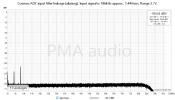In my early years I used play with lots of lab gear - oscilloscopes, sig gens, power meters and spectrum and network analysers.
I recall the latter had wide frequency and dynamic ranges, and I couldn't help wondering how well a modern signal analyser would fare as an audio analyser.
The vast majority don't go down below 9kHz; a few do reach 10 or 20Hz; but they're very expensive.
I hadn't realised, but there are actually quite a few dedicated audio analysers, with some familiar names, so I did a survey.
Typically, they have two analogue input/output channels that work over 10 to 80kHz, and many have options for digital I/O and additional channels.
There's a wide range of maximum voltage, and the I/O impedance is usually 100kohm/100 ohm.
The best ones I could find have a SINAD over 100dB, and they're all expensive (if they're even available at all).
The Rhode & Schwarz UPL models are also quite popular, but I couldn't find any specs (I guess it sits somewhere low down).
The Cosmos price includes the scaler so the input impedance is comparable, and the SINAD is Amir's stereo measurement (as they're all 2 channel).
As Audio Precision claims, nothing beats the APx555.
But I thought it would be useful to get some perspective on what E1DA and QuantAsylum had achieved, despite the best efforts of the big guns.
| Manufacturer | Model | Channels | Bandwidth | Analogue I/O | Digital I/O | Price $ | Spec SINAD | Typ SINAD |
| Audio Precision | APx555 | 2 | 80kHz | Y | Y | 30,000 | 117 | 120 |
| E1DA | Cosmos | 2 | 180kHz | N | N | 298 | 117 | 117 |
| Audio Precision | SYS2722 | 2 | 80kHz | Y | Y | 26,000 | 112 | 115 |
| Stanford Research Systems | SR1 | 2 | 200kHz | Y | Y | 17,000 | 109 | 113 |
| Agilent / HP | U8903A | 2 | 100kHz | O | O | (6000) | 108 | 110 |
| Audio Precision | APx525 | 2-4 | 80kHz | Y | Y | 27,000 | 108 | 110 |
| Keysight | U8903B | 2-8 | 80kHz | O | O | 28,000 | 108 | 110 |
| QuantAsylum | QA403 | 2 | 80kHz | N | N | 600 | 105 | 110 |
| Rhode & Schwarz | UPV | 2-8 | 250kHz | O | O | 12,000 | 105 | 110 |
| Audio Precision | APx516 | 2 | 80kHz | Y | Y | 6,000 | 109 | 109 |
| PrismSound / Spectral | dScope III | 2 | 200kHz | Y | Y | 4,400 | 105 | 108 |
| PrismSound / Spectral | dScope M1 | 2 | 90kHz | Y | Y | 4,400 | 105 | 108 |
| Rhode & Schwarz | UPP | 2 | 80kHz | Y | Y | (7000) | 100 | 105 |
| QuantAsylum | QA401 | 2 | 80kHz | N | N | 450 | 101 | 101 |


